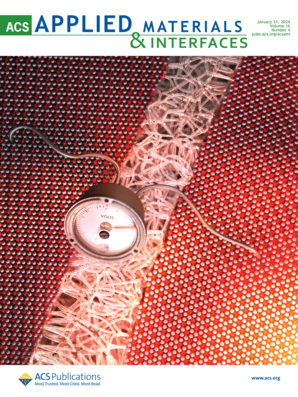基于双梯度裂纹结构的仿生超灵敏大量程柔性应变传感器。
IF 8.3
2区 材料科学
Q1 MATERIALS SCIENCE, MULTIDISCIPLINARY
引用次数: 0
摘要
高性能柔性应变传感器在包括可拉伸电子、软机器人和可穿戴设备在内的各种新兴领域至关重要。然而,传统的应变传感器往往面临着同时实现高灵敏度和宽检测范围的挑战,通常牺牲一个特性来增强另一个特性。在这里,我们提出了一种新的设计具有双梯度裂纹结构的薄膜厚度调制应变传感器。第一个梯度(局部尺度)有助于薄膜在拉伸过程中逐渐开裂,从而实现精确的机械响应。第二个梯度(全局尺度)调节整个表面上局部梯度的程度,其中小的局部梯度确保灵敏度,大的局部梯度扩大工作范围。相场模拟结果与实验结果一致,证实了薄膜厚度梯度调制的裂纹扩展是稳定可控的。双梯度裂纹应变传感器具有超高灵敏度(~ 9 × 106)和宽可探测应变范围(~ 80%)。此外,该传感器具有低检测限(0.02%)、短响应时间(~ 60 ms)和超过22,000个测试周期的优异耐用性。双梯度裂纹传感器擅长检测人体运动,从细微的面部表情到大的关节运动,突出了其在柔性电子和健康监测系统中的应用潜力。本文章由计算机程序翻译,如有差异,请以英文原文为准。
Bioinspired, Ultrasensitive and Wide-Range Flexible Strain Sensors Based on Dual-Gradient Crack Structures.
High-performance flexible strain sensors are crucial in various emerging fields including stretchable electronics, soft robots and wearable devices. However, traditional strain sensors often face challenges in achieving both high sensitivity and wide detection range simultaneously, typically sacrificing one characteristic to enhance the other. Here, we present a novel design of strain sensors featuring a dual-gradient crack structure by film thickness modulations. The first gradient (local scale) facilitates the gradual crack opening in the film during the stretching process, enabling precise mechanical response. The second gradient (global scale) modulates the degree of the local gradients across the entire surface, where small local gradients ensure sensitivity and large local gradients extend the working range. Phase field simulations confirm the stable and controlled crack propagation modulated by film thickness gradients, aligning with the experimental results. The dual-gradient crack strain sensor exhibits ultrahigh sensitivity (∼9 × 106) and wide detectable strain range (∼80%). Moreover, the sensor features a low detection limit (0.02%), short response time (∼60 ms), and excellent durability over 22,000 test cycles. The dual-gradient crack sensor excels in detecting human motions, from subtle facial expressions to large joint movements, highlighting its promising potential for applications in flexible electronics and health monitoring systems.
求助全文
通过发布文献求助,成功后即可免费获取论文全文。
去求助
来源期刊

ACS Applied Materials & Interfaces
工程技术-材料科学:综合
CiteScore
16.00
自引率
6.30%
发文量
4978
审稿时长
1.8 months
期刊介绍:
ACS Applied Materials & Interfaces is a leading interdisciplinary journal that brings together chemists, engineers, physicists, and biologists to explore the development and utilization of newly-discovered materials and interfacial processes for specific applications. Our journal has experienced remarkable growth since its establishment in 2009, both in terms of the number of articles published and the impact of the research showcased. We are proud to foster a truly global community, with the majority of published articles originating from outside the United States, reflecting the rapid growth of applied research worldwide.
 求助内容:
求助内容: 应助结果提醒方式:
应助结果提醒方式:


